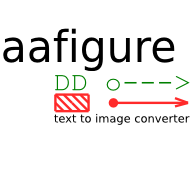Short introduction¶
Docutils & Sphinx integration¶
In a Sphinx document an image can be inserted like this:
.. aafig::
-->
Which results in an image like this:
The same contents could also have been placed in a file and then be converted with the aafigure command line tool.
Docutils directive¶
The aafigure directive has the following options:
:scale: <float> enlarge or shrink image
:line_width: <float> change line with (svg only currently)
:format: <str> choose backend/output format: ‘svg’, ‘png’, all bitmap formats that PIL supports can be used but only few make sense. Line drawings have a good compression and better quality when saved as PNG rather than a JPEG. The best quality will be achieved with SVG, tough not all browsers support this vector image format at this time.
:foreground: <str> foreground color in the form #rgb or #rrggbb
:background: <str> background color in the form #rgb or #rrggbb (not for SVG output)
:fill: <str> fill color in the form #rgb or #rrggbb
:name: <str> use this as filename instead of the automatic generated name
:aspect: <float> change aspect ratio. Effectively it is the width of the image that is multiplied by this factor. The default setting 1 is useful when shapes must have the same look when drawn horizontally or vertically. However, :aspect: 0.5 looks more like the original ASCII and even smaller factors may be useful for timing diagrams and such. But there is a risk that text is cropped or is draw over an object beside it.
The stretching is done before drawing arrows or circles, so that they are still good looking.
:proportional: <flag> use a proportional font instead of a mono-spaced one.
Sphinx directive¶
It is called aafig. The same options as for the Docutils directive apply with the exception of format. That option is not supported as the format is automatically determined.
Lines¶
The - and | are normally used for lines. _ and ~ can also be used. They are slightly longer lines than the -. _ is drawn a bit lower and ~ a bit upper. = gives a thicker line. The later three line types can only be drawn horizontally.
---- | ___ ~~~|
| -- ___| | ===
~~~
It is also possible to draw diagonal lines. Their use is somewhat restricted though. Not all cases work as expected.
And drawing longer diagonal lines with different angles looks ugly...
Boxes¶
Boxes are automatically draw when the edges are made with +, filled boxes are made with X (must be at least two units high or wide). It is also possible to make rounded edges in two ways:
+-----+ XXX /--\ -- |
| | XXX | | / /
+-----+ XXX \--/ | --
Fills¶
Upper case characters generate shapes with borders, lower case without border. Fills must be at least two characters wide or high. (This reduces the chance that it is detected as Fill instead of a string)
Complex shapes can be filled:
Text¶
The images may contain text too. There are different styles to enter text:
quoted¶
Text between quotes has priority over any graphical meaning:
"Hello World" dd d
d
", ' and \` are all valid quotation marks. The quotes are not visible in the resulting image. This not only disables fills (see below), it also treats -, | etc. as text.
textual option¶
The :textual: option disables horizontal fill detection. Fills are only detected when they are vertically at least 2 characters high:
Hello World dd d
d
